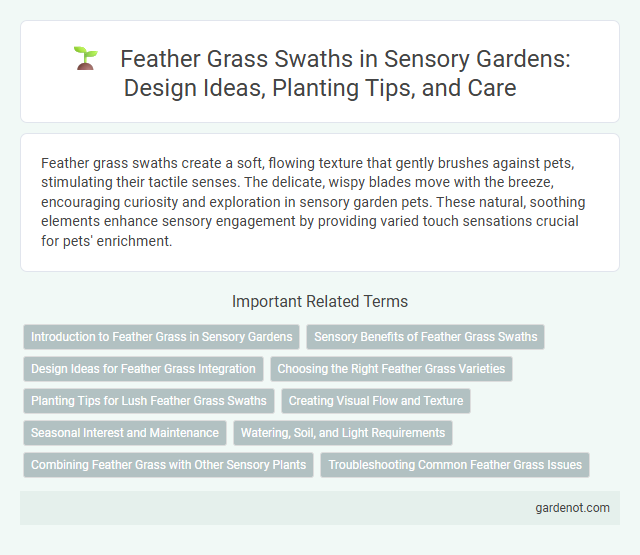Feather grass swaths create a soft, flowing texture that gently brushes against pets, stimulating their tactile senses. The delicate, wispy blades move with the breeze, encouraging curiosity and exploration in sensory garden pets. These natural, soothing elements enhance sensory engagement by providing varied touch sensations crucial for pets' enrichment.
Introduction to Feather Grass in Sensory Gardens
Feather grass swath creates a dynamic sensory experience with its soft, flowing plumes and gentle rustling sound, enhancing the tactile and auditory elements of a sensory garden. This ornamental grass thrives in well-drained soil and full sunlight, making it a resilient and low-maintenance choice for garden designers. Its delicate texture and movement engage visitors, promoting relaxation and mindfulness through natural sensory stimulation.
Sensory Benefits of Feather Grass Swaths
Feather grass swaths enhance sensory gardens by providing a unique tactile experience with their soft, feathery plumes that invite gentle touch and movement. The rustling sound created by feather grass in the breeze stimulates auditory senses, promoting relaxation and mindfulness. Visually, their elegant golden tones and graceful sway contribute to a calming environment, supporting stress reduction and sensory engagement.
Design Ideas for Feather Grass Integration
Incorporate feather grass swaths to create dynamic movement and soft texture within a sensory garden, enhancing tactile and visual appeal. Arrange clusters along winding paths or near seating areas to invite touch and gently rustle in the breeze, stimulating auditory senses. Pair feather grass with contrasting plants like bold succulents or vibrant flowers to highlight its delicate plumes and add seasonal interest.
Choosing the Right Feather Grass Varieties
Selecting the right feather grass varieties for a sensory garden enhances tactile and visual experiences with their soft, plumed foliage and graceful movement in the breeze. Popular choices include Stipa tenuissima, known for its fine, hair-like strands that create a delicate swath, and Stipa gigantea, which offers taller, feather-like plumes ideal for adding texture and height. Consider climate adaptability, growth habits, and maintenance needs to ensure the chosen feather grass thrives and complements the garden's sensory appeal.
Planting Tips for Lush Feather Grass Swaths
To cultivate lush feather grass swaths, choose well-drained, sandy or loamy soil with full sun exposure to encourage dense growth and vibrant plumes. Space plants about 18 to 24 inches apart to allow airflow and prevent overcrowding, reducing the risk of fungal diseases. Regularly trim dead foliage in early spring and provide moderate watering during dry spells to maintain healthy, thriving feather grass in your sensory garden.
Creating Visual Flow and Texture
Feather grass swaths create a dynamic visual flow in sensory gardens by their graceful, arching blades that move gently with the breeze, enhancing texture variety. Their soft, feathery plumes add a tactile dimension, inviting touch and engagement while contrasting with coarser foliage. Incorporating feather grass strategically guides visitors' movement and sightlines, enriching the immersive sensory experience.
Seasonal Interest and Maintenance
Feather grass swaths provide dynamic seasonal interest with their delicate, plume-like seed heads that shimmer in the breeze during late summer and autumn, adding texture and movement to sensory gardens. They require minimal maintenance, thriving in well-drained soil with full sun exposure, and benefit from annual pruning in early spring to encourage fresh growth. This hardy, drought-tolerant grass supports biodiversity by attracting pollinators and small wildlife, enhancing both aesthetic and ecological value.
Watering, Soil, and Light Requirements
Feather grass thrives in well-drained, sandy or loamy soil with moderate watering to prevent root rot while maintaining consistent moisture. It requires full sun exposure for at least six hours daily to promote dense, healthy growth and vibrant swath movement in the breeze. Proper watering, combined with optimal soil drainage and ample sunlight, enhances the ornamental texture and resilience of feather grass in a sensory garden setting.
Combining Feather Grass with Other Sensory Plants
Feather grass swaths create a dynamic texture that complements the aromatic intensity of lavender and the tactile softness of lamb's ear, enhancing the sensory garden experience. Pairing feather grass with colorful coneflowers enriches visual interest while attracting pollinators such as butterflies and bees. The rustling movement of feather grass combined with the vivid hues and scents of diverse sensory plants fosters an immersive natural environment.
Troubleshooting Common Feather Grass Issues
Feather grass swaths often face challenges such as fungal infections, root rot, and pest infestations that can stunt growth and discolor foliage. Proper soil drainage, adequate sunlight, and routine inspection for aphids or spider mites are essential to maintain plant health. Timely pruning of damaged blades and applying appropriate fungicides help mitigate common problems and promote lush, resilient feather grass displays in sensory gardens.
Feather grass swath Infographic

 gardenot.com
gardenot.com